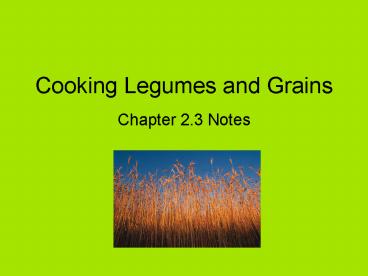Cooking Legumes and Grains - PowerPoint PPT Presentation
1 / 11
Title:
Cooking Legumes and Grains
Description:
Cooking Legumes and Grains Chapter 2.3 Notes Legumes and Grains Concentrated sources of nutrients Protein Fiber Vitamins Minerals Good-tasting Inexpensive Readily ... – PowerPoint PPT presentation
Number of Views:512
Avg rating:3.0/5.0
Title: Cooking Legumes and Grains
1
Cooking Legumes and Grains
- Chapter 2.3 Notes
2
Legumes and Grains
- Concentrated sources of nutrients
- Protein
- Fiber
- Vitamins
- Minerals
- Good-tasting
- Inexpensive
- Readily available
- Must be cooked
- To change their texture to be chewed and digested
- To develop their flavor
- To remove dirt, dust, or other natural substance
harmful to humans
3
Legumes
- Seeds from pod-producing plants
- Examples
- Yellow split peas
- Great Northern beans
- Kidney beans
- Pinto beans
- Lentils
- Navy beans
- Many uses in cooking
- Salads
- Appetizers
- Main course
- Dessert
4
Storing Legumes
- Store in cool, dry, well-ventilated areas
- Keep away from light and excessive heat
- Discard any beans or peas that appear moldy,
damp, or wrinkled - Can be kept for 1 to 2 years best used within 6
months of purchase
5
Cooking Legumes
- Rinse carefully and in some cases soak before
cooking - Rinse with cold water in colander or sieve
- Place in large pot of cold water any legumes
that float should be discarded - Soaking shortens the cooking time
- Legumes dont absorb water quickly
- Soak overnight in cold water or flavorful liquid
- Quick method boiled briefly and then soaked in
the hot water for one hour
6
Grains
- Grasses that grow edible seeds
- Essential for everyday cooking
- Whole Grains grains that have not been milled
- Milling process the germ, bran, and hull of the
grain are removed, or polished - Stone-ground grains that are ground and broken
down - Retain more nutrients because the germ, bran, and
hull are left intact
7
- Hull protective coating, or husk, that
surrounds the grain - Bran though layer surrounding the endosperm
- Endosperm largest part of the grain
- Germ smallest part of the whole grain
8
Grains
- Wheat classified as soft or hard, depending on
the protein content - All-purpose white flour good for making muffins
pancakes not making breads - Soft wheat good for making cakes pastries
- Hard wheat good for making bread
- Durum wheat type of hard wheat good for making
pasta - Semolina refined durum good for making pasta
9
Storing Grains
- Dry grains store above floor level on shelves
in a dry, ventilated, and accessible area - Whole grains store in freezer
- Brown rice and wild rice store in refrigerator
10
Cooking Grains
- Soak before cooking
- Water softens the outer layer, or bran
- Examples of methods of ways to cook grains
- Steaming
- Pilaf
- Risotto
11
- Steaming
- Cooked in double boiler
- Properly steamed grains should be tender to the
bite have good flavor - Pilaf
- Cooking grains in which the grain is sautéed
briefly in butter, then simmered in stock or
water with seasonings
- Risotto
- Rice is stirred constantly as small amounts of
hot liquid, usually flavored broth or water, are
added and absorbed - Starch gradually is released producing a creamy
texture - Best risotto has a porridge-like consistency
(sticky creamy)































